
Tick! Tack! is the second eroge visual novel in the Shuffle! series created by Navel for Microsoft Windows. The game is the first sequel to Navel's first game, Shuffle!, continuing Nerine's path.

Scilla section Chionodoxa, known as glory-of-the-snow, is a small group of bulbous perennial flowering plants in the family Asparagaceae, subfamily Scilloideae. Formerly treated as the separate genus Chionodoxa, they are now included in Scilla as a section. The section is endemic to the eastern Mediterranean, specifically Crete, Cyprus and Turkey. The blue, white or pink flowers appear early in the year making them valuable garden ornamentals. The common name of the group is based on the habit of flowering in high alpine zones when the snow melts in spring.

Cupressus forbesii, now reclassified by some as Hesperocyparis forbesii, and with the common names Tecate cypress or Forbes' cypress, is a species of cypress native to southwestern North America.
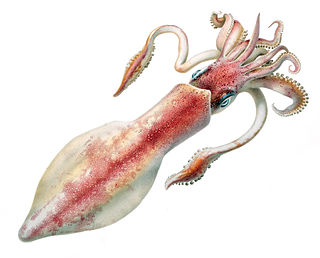
Loligo forbesii, known commonly as the veined squid and long-finned squid, is a commercially important species of squid in the family Loliginidae, the pencil squids.

Cattleya forbesii, or Forbes' cattleya, is a species of orchid. The diploid chromosome number of C. forbesii has been determined as 2n = 54–60.

Scilla forbesii, known as Forbes' glory-of-the-snow, is a bulbous perennial plant from west Turkey flowering in early spring. It is considered synonymous with Scilla siehei, known as Siehe's glory-of-the-snow, by some sources, although others distinguish them. It belongs to a group of Scilla species that were formerly put in a separate genus, Chionodoxa, and may now be treated as Scilla sect. Chionodoxa. After flowering, it goes into dormancy until the next spring. It seeds readily to form colonies.
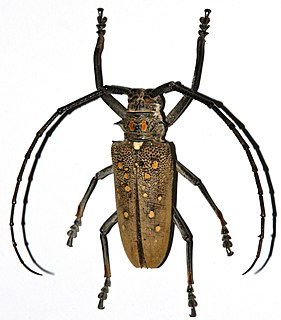
Batocera is a genus of the family Cerambycidae, subfamily Lamiinae, close to the genus Rosenbergia.

Batocera wallacei, common name Wallace’s long-horn beetle, is a species of flat-faced longhorn beetle in the subfamily Lamiinae of the family Cerambycidae. The species name honors Alfred Russel Wallace, who discovered this longhorn beetle on the Aru Islands in Indonesia. It was named after him by James Thomson in 1858.

Batocerini is a tribe of longhorn beetles of the subfamily Lamiinae.
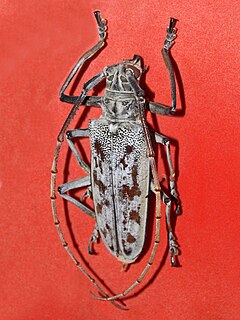
Batocera maculata is a species of flat-faced longhorn beetle in the subfamily Lamiinae of the family Cerambycidae. While originally named as "Lamia tigris" by Voet in 1778, no name was validly published for this species until 1817; Voet's 1778 work fails to fulfill the requirement in ICZN Article 11.4 that a work must be consistently binominal, and all names within that work are unavailable.

Batocera aeneonigra is a species of beetle in the family Cerambycidae. It was described by Thomson in 1859. It is found in Papua New Guinea, the Moluccas, and East Timor.
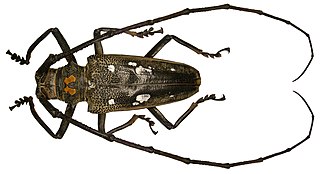
Batocera celebiana is a species of beetle in the family Cerambycidae. It was described by Thomson in 1858. It is known from Java, the Moluccas, and Sulawesi. It contains the subspecies Batocera celebiana pierrotae.

Batocera lineolata is a species of beetle in the family Cerambycidae. It was described by Chevrolat in 1852. It is known from China, Korea, Japan and Taiwan.
Batocera matzdorffi is a species of beetle in the family Cerambycidae. It was described by Kriesche in 1915. It is known from Papua New Guinea.
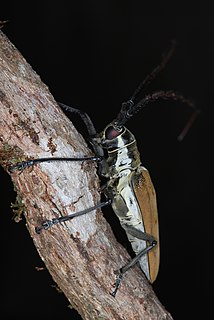
Batocera numitor, the mango-tree longicorn borer, is a species of beetle in the family Cerambycidae. It was described by Newman in 1842. It is known from China, Java, India, Laos, Nepal, Myanmar, the Philippines, Sulawesi, Sri Lanka, Thailand, Sumatra, and Vietnam. It feeds on plants including Mangifera indica and Quercus griffithii.

Batocera parryi is a species of beetle in the family Cerambycidae. It was described by Hope in 1845. It is known from China, India, Laos, Java, Myanmar, Malaysia, Sumatra, and Vietnam.

Batocera rubus is a species of beetle in the family Cerambycidae. It was described by Carl Linnaeus in his landmark 1758 10th edition of Systema Naturae. It is known from Japan, China, Java, India, Laos, Myanmar, Malaysia, the Philippines, South Korea, Taiwan, Sumatra, Thailand, and Vietnam. It feeds on Ficus carica, Ficus elastica, and Mangifera indica.

Batocera rufomaculata is a species of beetle in the family Cerambycidae. It was described by Charles De Geer in 1775. It is known from China, Israel, India, Jordan, Lebanon, Laos, Mauritius, Malaysia, Madagascar, Myanmar, Puerto Rico, Pakistan, Réunion, Syria, Sri Lanka, Thailand, Barbados, Bangladesh and the Virgin Islands. It feeds off of Ficus carica, Carica papaya, Mangifera indica, and Shorea robusta. It can be parasitically infected by Avetianella batocerae.
Micromeria forbesii is a species of flowering plants of the genus Micromeria. The species is endemic to Cape Verde. It is listed as endangered by the IUCN. It was first described by George Bentham in 1834. Its local name is erva-cidreira, or cidreirinha. In traditional medicine, it is used as an infusion for the treatment of indigestion, diarrhea, cough and to stimulate labour.















